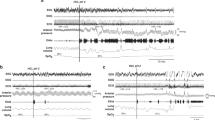Abstract
The effects of laryngoscopy and tracheal intubation on cerebral and systemic haemodynamics were studied in 30 children. The objective was to identify conditions in which the alterations of cerebral and systemic haemodynamics were minimal. The children were intubated after muscular relaxation and following 10 min of mechanical ventilation with endtidal halothane concentrations of 1.5%, 2.0% and 2.5%, respectively. With 1.5%, 2.0% and 2.5% endtidal halothane, the mean flow velocity increased by 26%, 19% and 5%, the mean blood pressure by 14%, 10% and 1%, and the heart rate by 26%, 8% and 5% respectively after intubation. Adverse effects of laryngoscopy and tracheal intubation on cerebral haemodynamics in children can be avoided by adequate anaesthetic protocols.
Similar content being viewed by others
References
Aaslid R (1987) Visually evoked dynamic blood flow response of the human cerebral circulation. Stroke 18:771–775
Adams HA, Bormann BV, Bachmann B, Ratthey K, Hempelmann G (1987) Untersuchungen zur endokrinen Stress-Reaktion bei orotrachealer Intubation und Oberflächenanaesthesie mit Lidocain. Anaesthesist 36:468
Bishop CR, Powell S, Rutt D, Browse NL (1986) Transcranial Doppler measurement of middle cerebral artery blood flow velocity: a validation study. Stroke 17:913–915
Black TE, Kay B, Healy TEJ (1984) Reducing the haemodynamic responses to laryngoscopy and intubation. Anaesthesia 39:883–887
Bode H (1991) Cerebral blood flow velocities during orthostasis and physical exercise. Eur J Pediatr 150:738–743
Bode H, Puglia E (1992) Intraindividuelle Variabilität zerebraler Blutflussgeschwindigkeitenbei wachen und schlafenden Kindern. Ultraschall Med 13:204–207
Charlton AJ, Greenhough SG (1988) Blood pressure response of neonates to tracheal intubation. Anaesthesia 43:744–746
Droste DW, Harders AG, Rastogi E (1989) A transcranial Doppler study of blood flow velocity in the middle cerebral arteries performed at rest and during mental activities. Stroke 20:1005–1011
Editoral (1987) Pain, anaesthesia and babies. Lancet II: 543–544
Faraci FM, Heistad DD (1990) Regulation of large arteries and cerebral microvascular pressure. Circ Res 66:8–17
Forbes AM, Dally FG (1970) Acute hypertension during induction of anaesthesia and endotracheal intubation in normotensive man. Br J Anaesth 42:618–624
Gregory GA (1989) Pediatric anaesthesia, 2nd edn. Churchill Livingstone, New York
Heinrichs W, Fauth U, Tzanova I, Karim S, Halmagyi M (1989) Der Einfluss von Nifedipin und Fentanyl auf Veränderungen der Kreislaufreaktion bei endotrachealer Intubation. Anaesthesist 38:466–475
Helfman SM, Gold MI, DeLisser EA, Herrington CA (1991) Which drug prevents tachycardia and hypertension associated with tracheal intubation: lidocaine, fentanyl, or esmol? Anesth Analg 72:482–486
Kaplan JD, Schuster DP (1991) Physiologic consequences of tracheal intubation. Clin Chest Med (US) 12:425–432
King BD, Harris LC Jr, Greifenstein FE, Elder JD Jr, Dripps RD (1951) Reflex circulatory responses to direct laryngoscopy and tracheal intubation performed during general anesthesia. Anesthesiology 12:556
Kirkham FJ, Padayachee TS, Parson S (1986) Transcranial measurements of blood velocities in the basal cerebral arteries using pulsed Doppler ultrasound: Velocity as an index of flow. Ultrasound Med Biol 12:15–21
Lassen NA, Ingvar DH, Skinhoj E (1978) Brain function and blood flow. Sci Am 239:62–71
Leon JE, Bissonnette B (1991) Cerebrovascular responses to carbon dioxide in children anaesthetized with halothane and isoflurane. Can J Anaesth 38:817–825
Lübbers DW (1972) Physiologie der Gehirndurchblutung. In: Gänshirt H (ed) Der Hirnkreislauf. Thieme, Stutgart, pp 214–254
Lundar T, Lindegaard K-F, Froysaker T, Aaslid R, Wiberg J, Nornes H (1985) Cerebral perfusion during nonpulsatile cardiopulmonary bypass. Ann Thorac Surg 40:144–150
Marshall TA, Deeder R, Pai S, Berkowitz GP, Austin TL (1984) Physiologic changes associated with endotracheal intubation in preterm infants. Crit Care Med 12:501–503
Mikawa K, Maekawa N, Goto R, Kaetsu H, Hasegawa M, Yaku H, Obara H (1991) Effects of pindolol on the cardiovascular response to tracheal intubation. Br J Anaesth 67:416–420
Parnass SM, Rothenberg DM, Kerchberger JP, Ivankovich AD (1990) A single bolus dose of esmolol in the prevention of intubation-induced tachycardia and hypertension in an ambulatory surgery unit. J Clin Anesth 2:232–237
Pathak D, Slater RM, Ping SS, From RP (1990) Effects of alfentanil and lidocaine on the hemodynamic responses to laryngoscopy and tracheal intubation. and anesthesia in infants. J Pediatr 96:860–862
Rivera R, Tibballs J (1992) Complications of endotracheal intubation and mechanical ventilation in infants and children. Crit Care Med (US) 20:192–199
Rogers MC (ed) (1992) Textbook of pediatric intensive care Vol. 1. Williams and Wilkins, Baltimore, pp 52–74
Tomori Z, Widdicombe JG (1969) Muscular, bronchomotor and cardiovascular reflexes elicited by mechanical stimulation of the respiratory tract. J Physiol 200:25
Yaku H, Mikawa K, Maekawa N, Obara H (1992) Effect of verapamil on the cardiovascular responses to tracheal intubation. Br J Anaesth 68:85–89
Author information
Authors and Affiliations
Rights and permissions
About this article
Cite this article
Bode, H., Ummenhofer, W. & Frei, F. Effects of laryngoscopy and tracheal intubation on cerebral and systemic haemodynamics in children under different protocols of anaesthesia. Eur J Pediatr 152, 905–908 (1993). https://doi.org/10.1007/BF01957527
Received:
Accepted:
Issue Date:
DOI: https://doi.org/10.1007/BF01957527




